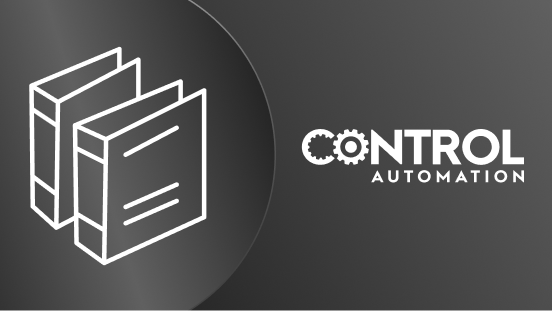
Modern DC and AC motor drives provide features useful when using electric motors as final control elements.…
Textbook

DC electric motors generate torque by a reaction between two magnetic fields: one field established by…
Textbook

AC induction motors are based on the principle of a rotating magnetic field produced by a set of stationary…
Textbook

The simplest form of 4-20 mA current loop is the type used to represent the output of a process controller,…
Textbook

An electric motor is often used as a discrete control element in a control system if driving a pump, conveyor…
Textbook

A simple control system drawn in block diagram form looks like this: Information from the measuring device…
Textbook

There are several different methods useful for causing an AC induction motor to brake, or slow down: DC…
Textbook

The following animation shows how the “rotating” magnetic field of a three-phase AC induction…
Textbook

The key to understanding how three-phase electric motors work is to have an accurate mental picture of the…
Textbook

Regulating the electric power sent to an electric motor is a task performed by high-speed switching…
Textbook

The reason why a pneumatic control valve’s stem position corresponds linearly to the amount of air…
Textbook

In order for any PID controller to be practical, it must be able to do more than just implement the PID…
Textbook

The simplest form of 4-20 mA current loop is the type used to represent the output of a process controller,…
Textbook

A limit switch detects the physical motion of an object by direct contact with that object. An example of a…
Textbook

Feedback Control System Components Before we begin our discussion on process control, we must define a few key…
Textbook

The vast majority of PID controllers in service today are digital in nature. Microprocessors executing PID…
Textbook

AC induction motors are based on the principle of a rotating magnetic field produced by a set of stationary…
Textbook

Perhaps the most basic and necessary protective relay function is overcurrent: commanding a circuit breaker to…
Textbook

DC electric motors generate torque by a reaction between two magnetic fields: one field established by…
Textbook

In addition to directly performing logic functions, electromechanical relays may also be used as interposing…
Textbook

Virtually any mass above absolute zero temperature emits electromagnetic radiation (photons, or light) as a…
Textbook

Process measurements are often of an analog nature: the temperature of a furnace, the rate of fluid flow…
Textbook

As discussed at the beginning of this chapter, instrumentation safety may be broadly divided into two…
Textbook

There are several different methods useful for causing an AC induction motor to brake, or slow down: DC…
Textbook

Non-dispersive analysis, while newer in discovery than dispersive analysis (Isaac Newton’s 17th-century…
Textbook

Negative feedback systems, in general, tend to cause confusion for those first learning their fundamental…
Textbook

Although it seems each model of PLC has its own idiosyncratic standard for programming, there does exist an…
Textbook

Modern DC and AC motor drives provide features useful when using electric motors as final control elements.…
Textbook

To better understand the design and operation of self-balancing pneumatic mechanisms, it is helpful to examine…
Textbook

Perhaps the most important rule of controller tuning is to know the process before attempting to adjust the…
Textbook

A level switch is one detecting the level of liquid or solid (granules or powder) in a vessel. Level switches…
Textbook

A quantitative PID tuning procedure is a step-by-step approach leading directly to a set of numerical values…
Textbook

A much simpler alternative to continuous vibration sensors (displacement or acceleration) and monitoring…
Textbook

When I began teaching full-time in 1998, most of what I thought I understood about good teaching was actually…
Textbook

First, let us review some of the properties of differentials and derivatives, referencing the expression and…
Textbook

Many years ago, when I was first learning about electricity, I happened to discover a length of coaxial…
Textbook

Current is the name we give to the motion of electric charges from a point of high potential to a point of low…
Textbook

By definition, a source is a device delivering energy into a system, while a load is a device extracting…
Textbook

One very convenient feature of waves is that their properties are universal. Waves of water in the ocean,…
Textbook

Few areas of mathematics are as powerfully useful in describing and analyzing the physical world as calculus:…
Textbook

Weight-based level instruments sense process level in a vessel by directly measuring the weight of the vessel.…
Textbook

Electromechanical relays may be connected together to perform logic and control functions, acting as logic…
Textbook

As a general rule, high achievement only takes place in an atmosphere of high expectations. Sometimes these…
Textbook

Since we often use electricity to convey energy from one location to another, it is important to be able to…
Textbook

Thermodynamics is the study of heat, temperature, and their related effects in physical systems. As a subject,…
Textbook

Several different technologies exist for the conversion of fluid pressure into an electrical signal response.…
Textbook

Process measurements are often of an analog nature: the temperature of a furnace, the rate of fluid flow…
Textbook

Perhaps the most important rule of controller tuning is to know the process before attempting to adjust the…
Textbook

There are many process control applications in the industry where it is desirable to have multiple control…
Textbook

Labwork is an essential part of any science-based curriculum. Here, much improvement may be made over the…
Textbook
